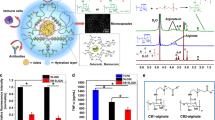Abstract
A simple procedure is described for the extraction and purification of alginate from the inner stipes of the kelp Laminaria pallida. Alginate yield was about 10–15% of the dry mass, with a 70:30 mannuronic/ guluronic acid ratio. Analysis of the purified alginate revealed a low polyphenol content while proteins were below detection level. The purified alginate was highly viscous, with 10–15 mPa s and 281 mPa s for a 0.1% and 0.5% solution, respectively, indicating a very high molecular mass (larger than 250 kDa). Bead formation occurred in the presence of divalent cations, but also in the presence of artificial serum (FCSIII) without added divalent cations. The biocompatibility of the alginate was tested with the in vitro mice lymphocyte test as well as by implantation of Ba2+ cross-linked beads beneath the kidney capsule of BB/OK rats. There was no evidence for significant mitogenic activity or fibrotic reaction. Biocompatibility of the alginate was also demonstrated by the encapsulation of human chondrocytes into Ca2+ cross-linked alginate beads. Immobilized chondrocytes grew and remained functional (i.e. they produced collagen).
Similar content being viewed by others
Author information
Authors and Affiliations
Additional information
Received: 14 June 1999 / Received revision: 6 September 1999 / Accepted: 10 September 1999
Rights and permissions
About this article
Cite this article
Jork, A., Thürmer, F., Cramer, H. et al. Biocompatible alginate from freshly collected Laminaria pallida for implantation. Appl Microbiol Biotechnol 53, 224–229 (2000). https://doi.org/10.1007/s002530050012
Issue Date:
DOI: https://doi.org/10.1007/s002530050012




